21.5-inch iMac (Late 2013) Review: Iris Pro Driving an Accurate Display
by Anand Lal Shimpi on October 7, 2013 3:28 AM ESTThe Display
When it was first announced, I shrugged off the 21.5-inch iMac model. At the time I was using a 27-inch Thunderbolt Display and couldn’t see myself using anything smaller, or lower resolution. With the new 27-inch iMac looking a lot like last year’s model with evolutionary upgrades on the internals, I was obviously drawn to the new 21.5-inch system because of its use of Intel’s Iris Pro 5200 graphics so I ended up with the first < 3MP desktop display I’d used since the release of the first 30-inch 2560 x 1600 panels years ago.
Given how much time I spend on notebook displays these days, now was as good a time as any to go back to a 1080p desktop display. While I’d prefer something with an insanely higher resolution, it’s still too early for a 21.5-inch 4K panel (or a 27-inch 5K panel), which Apple would likely move to in order to bring Retina displays to its desktops.
There are two reasons why you’d opt for the 21.5-inch iMac vs. the larger one: cost and size. At a bare minimum you’re looking at a $500 price difference between the 21.5 and 27-inch iMacs, which is pretty substantial to begin with. The size argument is just as easy to understand. The 27-inch iMac occupies a considerable amount of space on my desk, and I’ve come to realize that not everyone likes to be surrounded by a sea of desks. Either way there’s clearly a market for a computer this size, with this sort of a resolution. So how does the display fare?
In short: it’s nearly perfect.
Brian and I were comparing notes on the two reviews we’re working on at the same time. He sent me some CIE diagrams showing me color accuracy for the displays he’s testing, I responded with this:

21.5-inch iMac (Late 2013) Saturations
Those boxes show what’s expected, the circles inside of them show what’s delivered by the display. The 21.5-inch iMac is spot on, out of the box, without any calibration required. Brian’s response:
WOW
is that out of the box?
The iMac’s display does extremely well in all of our tests, always turning in a delta E of less than 2. It’s just incredible. I'm borrowing the graphs below from our tablet bench data, but I've tossed in the 2013 MacBook Air as a reference point.

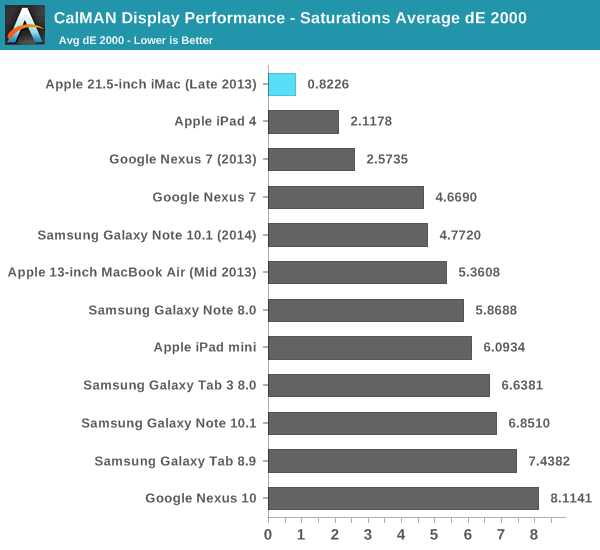
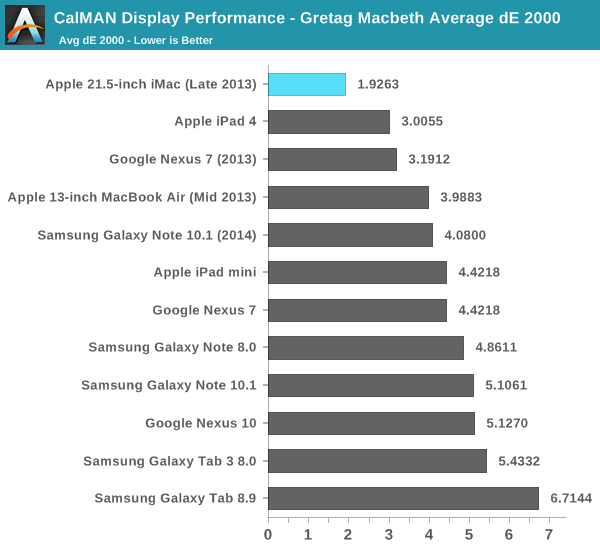

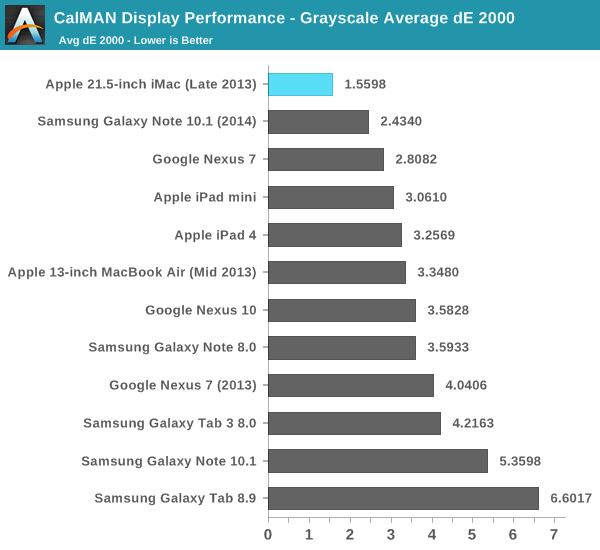
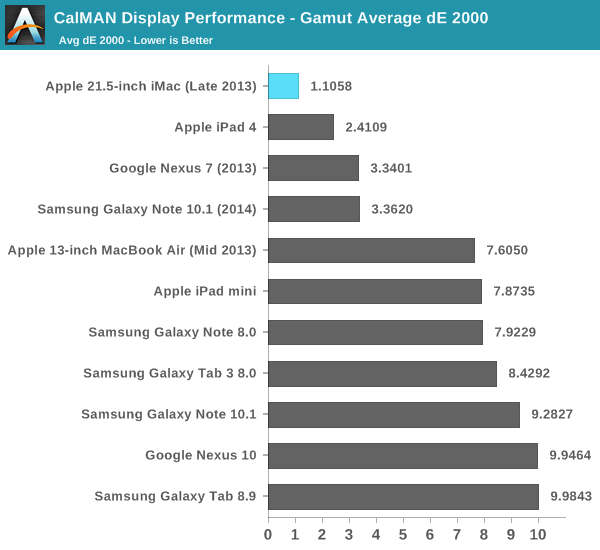

Although I doubt Apple’s intended audience for the entry-level 21.5-inch iMac are imaging professionals, they could very well use the system and be perfectly happy with it. Literally all that’s missing is a 2x resolution model, but my guess is it’ll be another year before we see that.
I have to point out that Apple does source its display panels from multiple providers (typically 2 or 3), not to mention panel variance within a lot. I don’t anticipate finding many panels better than the one in my review sample, but it’s always possible that there will be worse examples in the market. I haven’t seen huge variance in color accuracy from Apple panels, so I think it’s a pretty safe bet that what you’re going to get with any new iMac is going to be awesome.



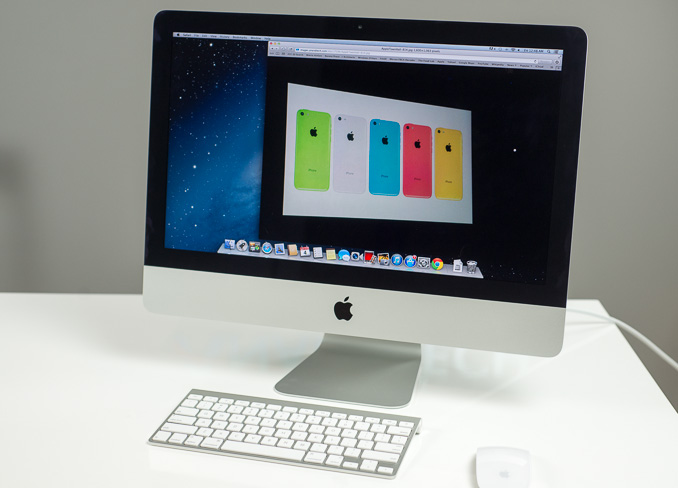











127 Comments
View All Comments
mschira - Tuesday, October 8, 2013 - link
Could one buy a super fast USB3 SSD and build ones' own fusion drive on the cheap?Cheers
M.
name99 - Wednesday, October 9, 2013 - link
Yes --- if you're willing to be daring.Essentially you'd need to boot off a third drive (or the network) then use diskutil cs commands to create an LVG then an LV tying the two drives together. There are instructions on the web giving details.
On a different point, I don't think Anand is correct in saying that Fusion works better than other hybrid solutions because it tracks blocks. I think the real answer is that it does a MUCH smarter job of tracking file "temperature". OSX has, since about 10.3, tracked file temperature (which is essentially a combination of how large the file is and how often it's accessed). This was done back then (and is still done) to move the hottest files to a small "hot files" area at the start of a disk for the obvious performance reasons.
Details here:
http://osxbook.com/book/bonus/misc/optimizations/#...
My guess is that Fusion essentially hooks into this mechanism, and just redefines the constants controlling how large the hot file area is to have it cover all of the SSD (minus of course the area for file system metadata, the area that is reserved for fast writes, and so on).
I can't think of any realistic situation (within pure OSX) where tracking by blocks rather than files is useful, and it would require a whole new way of looking at the problem. I think the obvious way to test this would be to look at the behavior of VM images which, assume, as a whole don't count as hot because they are very large, but which do have hot blocks inside them. If you look at IO when, say, starting up a VM, do you see all the IO coming from the HD, or do you see it all come from the SSD, with HD accesses coming later once the VM is booted and we're now pulling in less frequently accessed blocks?
Risas - Thursday, October 10, 2013 - link
What a silly review and comparison. Apple vs Apple, conclusión: the Moore's law still works.CPU performance: It look like Apple made any work instead of changing the Intel CPU, Apple CPU performance comparison? there's no other comparison of the Intel's CPUs? Just look at them, what to spect?
And over and over... Apple iMAc vs Apple iMacs, who wins? Apple, of course.
Final words..."Apple continues to have the strongest Mac lineup of its history" Does any other have MAC lineups? Of course no, as it's a monopolistic stuff. So It's unnecesary to say what's obvious.
Apple's Haswell?? yo write the article as if Apple did anything on the Haswell desing or manufacture.... Maybe Intel have to say something about it...
And here is what really matters: The iMac’s industrial design is beautiful.
No complains about the small breaking-wrist keyboard or any thing as Apple fights againts Apple it wold be always a winner: Apple.
Commodus - Thursday, October 17, 2013 - link
I'd say the Apple vs. Apple comparisons are valid because of the limited all-in-one market. It's hard to find something comparable; a lot of iMac alternatives are either budget models or use significantly different components (see the ASUS Transformer AIO or Lenovo IdeaCentre A730 as examples). The company practically dominates the category, at least in North America and Europe.Haplodepatrijn - Thursday, October 10, 2013 - link
Doses this mean we can finally use the GPU render in Blender ?shweetuant - Friday, October 25, 2013 - link
HiIf I am planning to install Windows 7 64-bit as virtual running side by side with OS X. Is the default 8GB of ram sufficient?
kkirk - Tuesday, December 3, 2013 - link
I was wondering if there will be a late 2013 Macbook Pro 15" review coming soon?